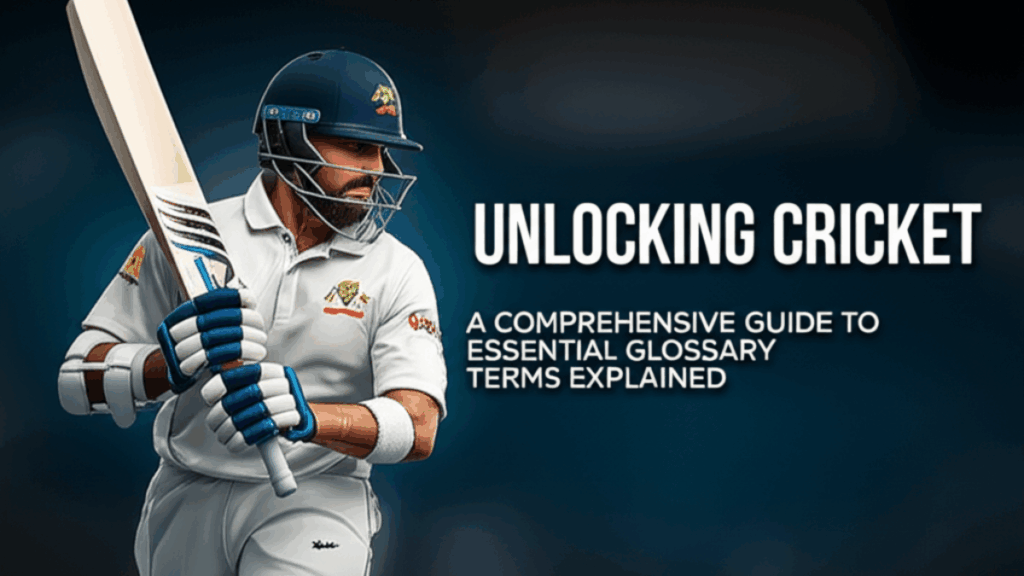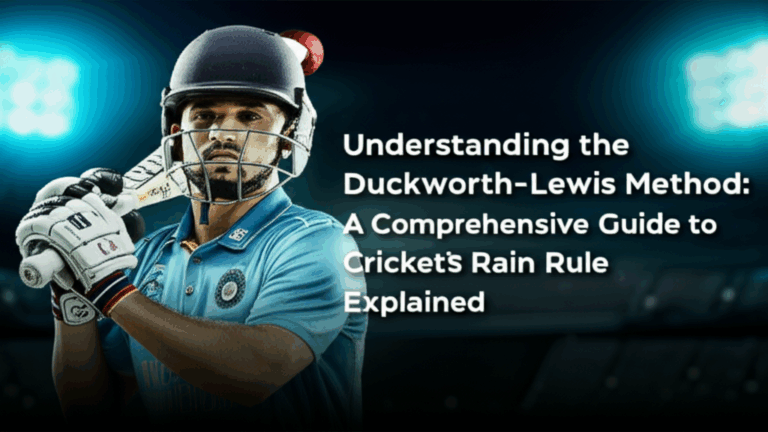
Cricket is much more than just a sport; it’s a global phenomenon that brings together millions of fans around the world. If you’ve ever watched a match, you might have found yourself puzzled by the terminology used by commentators and players alike. Terms like “Yorker,” “Googly,” and “LBW” can sound like a foreign language to the uninitiated. But fear not! In this comprehensive guide, we’re going to unlock the world of cricket by explaining essential glossary terms that will enhance your understanding of the game.
This article is designed to be your ultimate resource, whether you’re a budding player, an enthusiastic fan, or someone curious about the sport. We’ll break down the jargon into digestible bits, helping you not only to follow the game but to appreciate its intricacies. By the end of this guide, you’ll be equipped with the vocabulary needed to engage in discussions about cricket with confidence and flair.
Here’s what you can expect to learn as we journey through the essentials of cricket terminology:
- Understanding the foundational terms that define cricket.
- Exploring key components of the game, including player roles and formats.
- The importance of these terms in enhancing your viewing experience.
- Practical applications of cricket terminology in real-world contexts.
So, let’s dive into the exciting world of cricket terminology and unlock the secrets that make this sport so beloved!
Understanding Cricket Terminology
Before we delve into specific terms, it’s vital to understand the structure of cricket. The sport is played between two teams, each consisting of eleven players. The basic objective is to score more runs than the opposing team. However, the terminology used in cricket often reflects the strategic depth and history of the game. Let’s break down some of the most essential terms you’ll come across.
1. Batting Terms
- Run: The fundamental unit of scoring in cricket. Runs are scored by the batsmen running between the wickets after hitting the ball.
- Boundary: A scoring method where the ball reaches the edge of the field. Hitting the ball beyond the boundary on the full results in six runs; if it bounces before crossing, it’s four runs.
- Strike: The batsman facing the bowler is said to be on strike. The other batsman is at the non-striker’s end.
- Century: A milestone achievement for a batsman, scoring 100 runs in a single innings.
2. Bowling Terms
- Bowler: The player who delivers the ball to the batsman, aiming to dismiss them.
- Yorker: A delivery aimed at the batsman’s feet, making it difficult to hit effectively.
- Googly: A deceptive delivery by a leg-spin bowler that turns in the opposite direction to what the batsman expects.
- Over: A set of six legal deliveries bowled by one bowler. After an over, the bowling changes to a different bowler.
3. Fielding Terms
- Catch: When a fielder catches the ball before it touches the ground after the batsman hits it, resulting in the batsman being dismissed.
- Slip: A fielding position located next to the wicketkeeper, used primarily to catch balls that edge off the batsman’s bat.
- Run Out: A method of dismissal where the batsman fails to reach the crease before the fielding side successfully breaks the wicket with the ball.
Key Components of Cricket
Understanding cricket goes beyond just knowing the glossary terms. It also involves grasping the key components that define the game’s structure and play. Here, we’ll discuss player roles, various formats, and the overall objective of the game.
1. Player Roles
Each player in a cricket team has a specific role, and these roles can often dictate the strategy employed by the team:
- Batsmen: Players who specialize in scoring runs. Top-order batsmen usually play more aggressively, while lower-order batsmen are often tasked with supporting the innings.
- Bowlers: Players who aim to dismiss the opposing batsmen. They can be categorized into fast bowlers and spin bowlers, each with unique skills and techniques.
- All-rounders: Players proficient in both batting and bowling, providing balance to the team.
- Wicketkeeper: A specialized fielder who stands behind the stumps to catch the ball and execute run outs.
2. Formats of the Game
Cricket is played in several formats, each with distinct rules and pacing:
- Test Cricket: The longest format, played over five days. Each team bats twice, and matches can end in a draw.
- One Day Internationals (ODIs): Each team bats for a maximum of 50 overs. The match typically lasts around eight hours.
- Twenty20 (T20): The shortest format, where each team bats for a maximum of 20 overs. Matches usually finish in about three hours.
Benefits and Importance of Understanding Cricket Terms
Knowing cricket terminology enriches your experience as a fan or player. Here are some of the benefits:
- Enhanced Viewing Experience: When you understand the terms, you can appreciate the strategies employed by players and teams.
- Better Communication: Engaging in conversations about cricket becomes more enjoyable and insightful with the right vocabulary.
- Improved Playing Skills: Recognizing terms can help players understand coaching techniques and strategies, leading to better performance.
Practical Applications of Cricket Terminology
Now that we’ve explored the essential terms and their meanings, let’s look at how you can apply this knowledge practically. Whether you’re watching a match, playing in a local league, or discussing cricket with friends, these terms will come in handy:
1. Watching Matches
When you tune in to a cricket match, try to identify the terms as they are used. For instance, if a commentator mentions a “yorker,” pay attention to how the batsman responds. This kind of engagement will deepen your understanding of the game’s nuances.
2. Playing Cricket
If you’re playing cricket, familiarize yourself with the terms relevant to your role. Batsmen should understand the significance of shot selection, while bowlers should learn about various deliveries they can use to deceive batsmen.
3. Discussing Cricket
In conversations with friends or online forums, using the right terminology can help you express your thoughts clearly and confidently. For example, discussing a bowler’s “economy rate” or a batsman’s “strike rate” can lead to more meaningful discussions about performances and match outcomes.
Frequently Asked Questions
What is the significance of the term ‘LBW’?
LBW, or “Leg Before Wicket,” is a mode of dismissal in cricket. It occurs when a batsman is out if, in the umpire’s opinion, the ball would have hit the stumps but strikes the batsman’s leg instead. Understanding LBW is crucial because it highlights the importance of batting technique and the bowler’s strategy.
What does ‘economy rate’ mean in cricket?
The economy rate is a statistic that measures a bowler’s effectiveness, indicating how many runs they concede per over bowled. A lower economy rate suggests that a bowler is successful in restricting runs, which is especially important in limited-overs formats.
How does a ‘no-ball’ differ from a ‘wide’?
A no-ball is an illegal delivery due to overstepping the crease or other infractions, resulting in a run awarded to the batting team and an extra ball bowled. A wide, on the other hand, occurs when a delivery is out of the batsman’s reach, also resulting in an extra run and an additional ball. Both affect the game but in different ways.
Why is a ‘catch’ so critical in cricket?
Catching is one of the most crucial skills in cricket as it directly leads to dismissals. A successful catch can change the momentum of the game, often leading to the dismissal of key batsmen. Understanding the importance of positioning and technique in catching can significantly impact a player’s effectiveness on the field.
What does ‘innings’ refer to in cricket?
An innings refers to a period in which a team or a batsman bats. In Test cricket, each team has two innings; in ODIs and T20s, each team has one. The innings ends when ten batsmen are out or the overs are completed, and understanding this term is essential to grasping the flow of the game.
How does rain affect a cricket match?
Rain can significantly impact a cricket match, especially in limited-overs formats. If rain interrupts play, the Duckworth-Lewis-Stern (DLS) method may be used to adjust target scores based on overs lost. Understanding this concept is crucial for following match outcomes in inclement weather.
Conclusion
Cricket terminology might seem daunting at first, but as we’ve explored, it forms the foundation of understanding and enjoying the game. By familiarizing yourself with essential terms, you not only enhance your viewing experience but also deepen your appreciation for the strategies and skills involved in cricket.
I encourage you to put your newfound knowledge into practice—watch a match with friends, participate in discussions, or even try playing cricket yourself. The more you engage with the terminology, the more fluent you’ll become in the language of cricket.
If you found this guide helpful, share it with friends or fellow cricket enthusiasts. Let’s spread the joy of cricket together! And remember, the next time you hear a term you don’t understand, you have the tools to unlock its meaning and enjoy the game even more.




